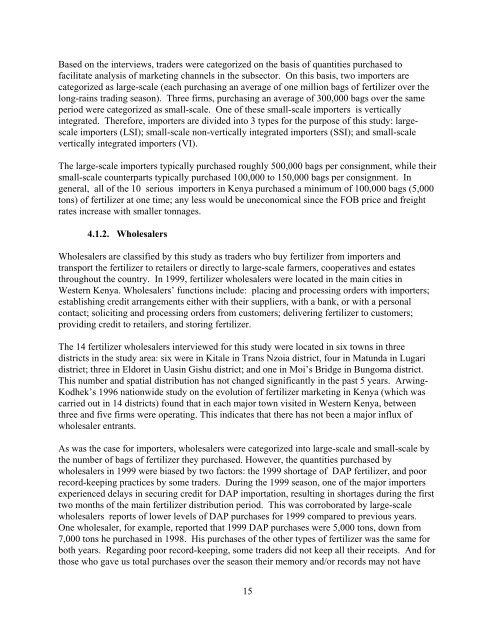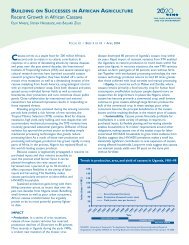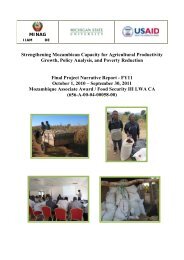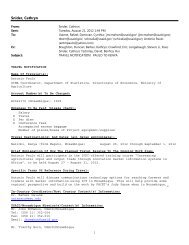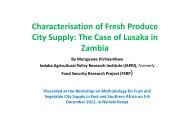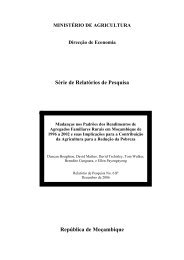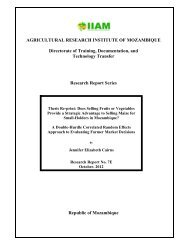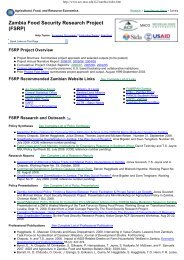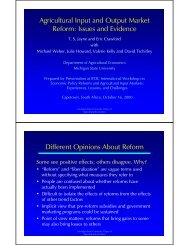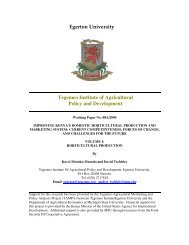Fertilizer Markets and Agricultural Production Incentives - Tegemeo ...
Fertilizer Markets and Agricultural Production Incentives - Tegemeo ...
Fertilizer Markets and Agricultural Production Incentives - Tegemeo ...
Create successful ePaper yourself
Turn your PDF publications into a flip-book with our unique Google optimized e-Paper software.
Based on the interviews, traders were categorized on the basis of quantities purchased to<br />
facilitate analysis of marketing channels in the subsector. On this basis, two importers are<br />
categorized as large-scale (each purchasing an average of one million bags of fertilizer over the<br />
long-rains trading season). Three firms, purchasing an average of 300,000 bags over the same<br />
period were categorized as small-scale. One of these small-scale importers is vertically<br />
integrated. Therefore, importers are divided into 3 types for the purpose of this study: largescale<br />
importers (LSI); small-scale non-vertically integrated importers (SSI); <strong>and</strong> small-scale<br />
vertically integrated importers (VI).<br />
The large-scale importers typically purchased roughly 500,000 bags per consignment, while their<br />
small-scale counterparts typically purchased 100,000 to 150,000 bags per consignment. In<br />
general, all of the 10 serious importers in Kenya purchased a minimum of 100,000 bags (5,000<br />
tons) of fertilizer at one time; any less would be uneconomical since the FOB price <strong>and</strong> freight<br />
rates increase with smaller tonnages.<br />
4.1.2. Wholesalers<br />
Wholesalers are classified by this study as traders who buy fertilizer from importers <strong>and</strong><br />
transport the fertilizer to retailers or directly to large-scale farmers, cooperatives <strong>and</strong> estates<br />
throughout the country. In 1999, fertilizer wholesalers were located in the main cities in<br />
Western Kenya. Wholesalers’ functions include: placing <strong>and</strong> processing orders with importers;<br />
establishing credit arrangements either with their suppliers, with a bank, or with a personal<br />
contact; soliciting <strong>and</strong> processing orders from customers; delivering fertilizer to customers;<br />
providing credit to retailers, <strong>and</strong> storing fertilizer.<br />
The 14 fertilizer wholesalers interviewed for this study were located in six towns in three<br />
districts in the study area: six were in Kitale in Trans Nzoia district, four in Matunda in Lugari<br />
district; three in Eldoret in Uasin Gishu district; <strong>and</strong> one in Moi’s Bridge in Bungoma district.<br />
This number <strong>and</strong> spatial distribution has not changed significantly in the past 5 years. Arwing-<br />
Kodhek’s 1996 nationwide study on the evolution of fertilizer marketing in Kenya (which was<br />
carried out in 14 districts) found that in each major town visited in Western Kenya, between<br />
three <strong>and</strong> five firms were operating. This indicates that there has not been a major influx of<br />
wholesaler entrants.<br />
As was the case for importers, wholesalers were categorized into large-scale <strong>and</strong> small-scale by<br />
the number of bags of fertilizer they purchased. However, the quantities purchased by<br />
wholesalers in 1999 were biased by two factors: the 1999 shortage of DAP fertilizer, <strong>and</strong> poor<br />
record-keeping practices by some traders. During the 1999 season, one of the major importers<br />
experienced delays in securing credit for DAP importation, resulting in shortages during the first<br />
two months of the main fertilizer distribution period. This was corroborated by large-scale<br />
wholesalers reports of lower levels of DAP purchases for 1999 compared to previous years.<br />
One wholesaler, for example, reported that 1999 DAP purchases were 5,000 tons, down from<br />
7,000 tons he purchased in 1998. His purchases of the other types of fertilizer was the same for<br />
both years. Regarding poor record-keeping, some traders did not keep all their receipts. And for<br />
those who gave us total purchases over the season their memory <strong>and</strong>/or records may not have<br />
15


